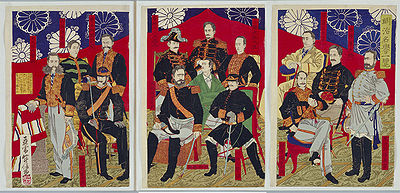
Genroin
Encyclopedia

National Assembly
National Assembly is either a legislature, or the lower house of a bicameral legislature in some countries. The best known National Assembly, and the first legislature to be known by this title, was that established during the French Revolution in 1789, known as the Assemblée nationale...
in early Meiji
Meiji period
The , also known as the Meiji era, is a Japanese era which extended from September 1868 through July 1912. This period represents the first half of the Empire of Japan.- Meiji Restoration and the emperor :...
Japan
Japan
Japan is an island nation in East Asia. Located in the Pacific Ocean, it lies to the east of the Sea of Japan, China, North Korea, South Korea and Russia, stretching from the Sea of Okhotsk in the north to the East China Sea and Taiwan in the south...
, established after the Osaka Conference of 1875
Osaka Conference of 1875
The was a meeting held by the major leaders of the Meiji Restoration in Osaka, Japan from January-February 1873 to address the issue of forming a representative assembly....
. It is also referred to as the Senate
Senate
A senate is a deliberative assembly, often the upper house or chamber of a legislature or parliament. There have been many such bodies in history, since senate means the assembly of the eldest and wiser members of the society and ruling class...
of Japan, Genrōin being the word used to describe the Roman Senate, and other western legislatures named after it.
The Freedom and People's Rights Movement
Freedom and People's Rights Movement
The was a Japanese political and social movement for democracy in 1880s....
and liberals among the Meiji oligarchy
Meiji oligarchy
The Meiji oligarchy was the name used to describe the new ruling class of Meiji period Japan. In Japanese, the Meiji oligarchy is called the ....
had withdrawn from the Meiji government
Government of Meiji Japan
The Government of Meiji Japan was the government which was formed by politicians of the Satsuma Domain, Chōshū Domain and Tenno. The Meiji government was the early government of the Empire of Japan....
over their efforts to establish a national assembly with increased representative democracy
Representative democracy
Representative democracy is a form of government founded on the principle of elected individuals representing the people, as opposed to autocracy and direct democracy...
. The Osaka Conference of 1875 attempted to address this issue by the establishment of the Genrōin, a national assembly whose members (theoretically appointed directly by the Emperor) were drawn from the peerage
Kazoku
The was the hereditary peerage of the Empire of Japan that existed between 1869 and 1947.-Origins:Following the Meiji Restoration of 1868, the ancient court nobility of Kyoto regained some of its lost status...
, upper ranks of the bureaucracy and various scholars. The Genrōin was only quasi-legislative, in that it had the power to review proposed legislation
Legislation
Legislation is law which has been promulgated by a legislature or other governing body, or the process of making it...
and make recommendations, but did not have the power to actually initiate any legislation. As an assembly, it replaced the .
In 1876, the Genrōin was given the task of drafting a constitution
Constitution
A constitution is a set of fundamental principles or established precedents according to which a state or other organization is governed. These rules together make up, i.e. constitute, what the entity is...
for Japan, which it completed in 1880, only to have the draft rejected by Itō Hirobumi
Ito Hirobumi
Prince was a samurai of Chōshū domain, Japanese statesman, four time Prime Minister of Japan , genrō and Resident-General of Korea. Itō was assassinated by An Jung-geun, a Korean nationalist who was against the annexation of Korea by the Japanese Empire...
and Iwakura Tomomi
Iwakura Tomomi
was a Japanese statesman in the Meiji period. The former 500 Yen banknote issued by the Bank of Japan carried his portrait.-Early life:Iwakura was born in Kyoto as the second son of a low-ranking courtier and nobleman . In 1836 he was adopted by another nobleman, , from whom he received his family...
as being too liberal.
The Genrōin was replaced by the Imperial Diet
Diet of Japan
The is Japan's bicameral legislature. It is composed of a lower house, called the House of Representatives, and an upper house, called the House of Councillors. Both houses of the Diet are directly elected under a parallel voting system. In addition to passing laws, the Diet is formally...
in 1890.
The Genrōin should not be confused with the Genrō
Genro
was an unofficial designation given to certain retired elder Japanese statesmen, considered the "founding fathers" of modern Japan, who served as informal extraconstitutional advisors to the emperor, during the Meiji, Taishō and early Shōwa periods in Japanese history.The institution of genrō...
, or elder statesmen. Most of the Genrō were members of the Genrōin, but not all members of the Genrōin were Genrō.

